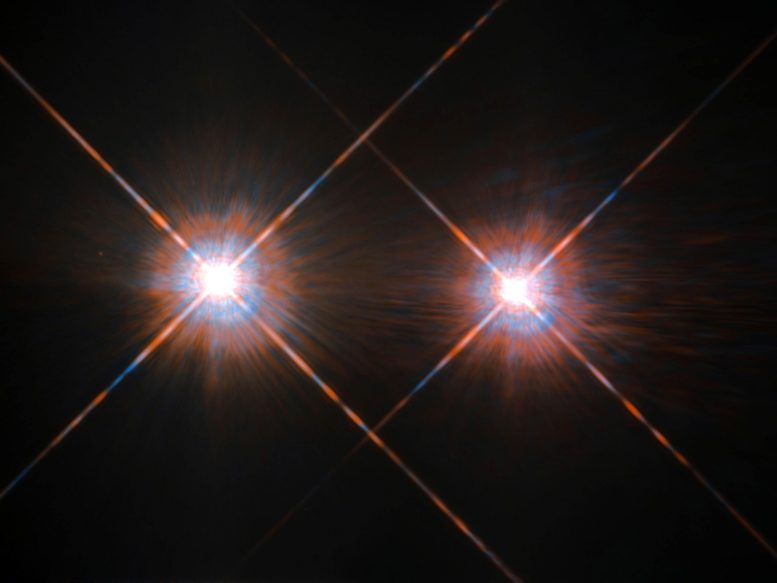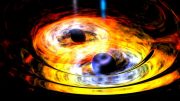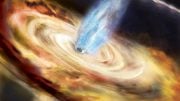
An image of the binary stars Alpha Centauri A (left) and Alpha Centauri B, taken by the Hubble Space Telescope. Located in the constellation of Centaurus (The Centaur), at a distance of 4.3 light-years, the star pair orbits a common center of gravity once every 80 years, with an average distance of about 11 times the distance between Earth and the sun. Credit: NASA/ESA/Hubble
Astronomers have found that young supermassive stars near the Milky Way’s black hole are single, not binary, a finding contrary to normal supermassive star formation. The black hole’s extreme environment causes these stellar binaries to merge or disrupt, leading to fewer binary pairs compared to similar stars near Earth. This suggests the black hole’s influence on gravitational waves production and hypervelocity star creation.
- The University of California, Los Angeles (UCLA) and W. M. Keck Observatory scientists analyzed over a decade’s worth of data about 16 young supermassive stars orbiting the supermassive black hole at the center of the Milky Way galaxy.
- Supermassive stars typically are formed in pairs, but the new study found that all 16 of the stars were singletons.
- The findings support a scenario in which the supermassive black hole drives nearby stars to either merge or be disrupted, with one of the pair being ejected from the system.
When supermassive stars are born, they’re almost always paired with a twin, and the two stars normally orbit one another.
But astronomers at UCLA’s Galactic Center Group and the Keck Observatory have analyzed over a decade’s worth of data about 16 young supermassive stars orbiting the supermassive black hole at the center of the Milky Way galaxy. Their findings, published recently in the Astrophysical Journal, reveal a startling conclusion: All of them are singletons.
But why? Are the stars, which are about 10 times larger than our sun, being formed alone in the hostile environment around the black hole? Have their “twins” been kicked out by the black hole? Or have pairs of stars merged to form single stars?
The findings support a scenario in which the central supermassive black hole drives nearby stellar binaries to merge or be disrupted, with one of the pair being ejected from the system.
The stars the scientists observed are known as S-stars, and most of them are young — formed within the past 6 million years — and massive. They are mostly located within a light-month, or a little under 500 billion miles, of the black hole.
“Stars this young shouldn’t even be near the black hole in the first place,” said UCLA postdoctoral scholar Devin Chu, the study’s first author. “They couldn’t have migrated to this region in just 6 million years. But to have a star form in such a hostile environment is surprising.”
Chu and his colleagues used data taken with Keck’s adaptive optics instruments to conduct the first-ever search for spectroscopic binary stars among the S-stars. Spectroscopic binary stars appear through optical telescopes to be single stars but, when the light they emit is analyzed by scientists, are revealed to actually be pairs of stars.
All of the S-stars that appeared to be single were, in fact, alone.
Even more surprising, the researchers found that the number of pairs of S-stars that could possibly exist near the black hole was much lower than the number of comparable stars in the section of space surrounding Earth’s sun, known as the solar neighborhood.
They did this by calculating a metric called the binary fraction, which defines how many stars in a given area could come in pairs; the higher the binary fraction, the more stars that could exist in pairs. Previous studies have shown that the binary fraction for stars similar to S-stars in Earth’s solar neighborhood is around 70%. In the new study, the researchers found that near the Milky Way’s black hole, the upper limit is just 47% —suggesting that the extreme environment of the black hole is limiting the survival of stellar binaries.
“This difference speaks to the incredibly interesting environment of the center of our galaxy; we’re not dealing with a normal environment here,” Chu said. “This also suggests that the black hole drives these nearby binary stars to merge or be disrupted, which has important implications for the production of gravitational waves and hypervelocity stars ejected from the galactic center.”
The UCLA researchers now plan to explore how the limit on the binary fraction they calculated compares to the binary fraction for similar stars that are located farther from the black hole, but still within its gravitational influence.
Reference: “Evidence of a Decreased Binary Fraction for Massive Stars within 20 milliparsecs of the Supermassive Black Hole at the Galactic Center” by Devin S. Chu, Tuan Do, Andrea Ghez, Abhimat K. Gautam, Anna Ciurlo, Kelly Kosmo O’neil, Matthew W. Hosek Jr., Aurélien Hees, Smadar Naoz, Shoko Sakai, Jessica R. Lu, Zhuo Chen, Rory O. Bentley, Eric E. Becklin and Keith Matthews, 11 May 2023, Astrophysical Journal.
DOI: 10.3847/1538-4357/acc93e









So after reading the above paper, I wrote this: A bad paper about binarys and B-Type Stars
Stated in the scitechdaily paper
Even more surprising, the researchers found that the number of pairs of S-stars that could possibly exist near the black hole was much lower than the number of comparable stars in the section of space surrounding Earth’s sun, known as the solar neighborhood.
Stated in referents paper
Unlike their cousins outside the central radius of 0.04 pc
For the young, massive stars, we make use of the ((Sana et al(2012)
(This paper only uses O-type objects !!!)
“Our sample contains 71 single and multiple O-type objects (see supporting online text§A). With 40 identified spectroscopic binaries, the observed binary fraction in our sample is fobs = 40 / 71 = 0.56.”)) distributions of binary system parameters (mass ratios q, eccentricities, and periods).
None of the info list below, from Celestia Stars program, are in the Solar neighborhood.
THIS STARS IS LISTED FOR REFERENTS OF (e=)
distance to Stars form Sol
dts = 1370.4 ly, MAG: Abs -.18 (App 7.93 )
101 x Sun at .69816 au, e = .06190010819
1.5 Radius(1.04 x 10^9m) 30,000 K, ref: HIP 008738, B0(V), n o t 398.0 ly
Stars Mass = 7.433446283 x 10^30
LIST OF SUPER MASSIVE STARS
dts = .51546 Kpc, MAG: Abs -2.82 (App 5.74 )
1,150 x Sun at 2.3513 au, e = .06152466056
5.1 Radius(3.52 x 10^9m) 30,000 K, ref: HIP 074750, B0V, n o t 498.8 ly
Stars Mass = 14.89402419 x 10^30
dts = 404.17 ly, MAG: Abs -2.9 (App 2.56 )
1,240 x Sun at 2.4418 au, e = .06169822489
5.2 Radius(3.65 x 10^9m) 30,000 K, ref: HIP 078820, BET 1 Sco, B0V, n o t 114.7 ly
Stars Mass = 15.21814525 x 10^30
dts = 474.08 ly, MAG: Abs -2.99 (App 2.82 )
1,340 x Sun at 2.5358 au, e = .06183909019
5.5 Radius(3.79 x 10^9m) 30,000 K, ref: HIP 052419, TET Car, B0V, n o t 131.6 ly
Stars Mass = 15.55913581 x 10^30
dts = , MAG: Abs (App )
1,340 x Sun at 2.5403 au, e = .06151404954
5.5 Radius(3.8 x 10^9m) 30,000 K, ref: HIP 081266, TAU Sco, B0V, n o t 126.3 ly
Stars Mass = 15.55913581 x 10^30
dts = 1.3889 Kpc, MAG: Abs -3.23 (App 7.48 )
1,680 x Sun at 2.8401 au, e = .06165497622
6.1 Radius(4.25 x 10^9m) 30,000 K, ref: HIP 107442, B0V, n o t 2,392.0 ly
Stars Mass = 16.59754655 x 10^30
dts = 638.29 ly, MAG: Abs -3.55 (App 2.9 )
2,260 x Sun at 3.2974 au, e = .06163839385
7.1 Radius(4.93 x 10^9m) 30,000 K, ref: HIP 018532, EPS Per, B0V, n o t 184.3 ly
Stars Mass = 18.06523663 x 10^30
dts = 1614.7 ly, MAG: Abs -3.69 (App 4.78 )
2,560 x Sun at 3.5117 au, e = .0615684289
7.5 Radius(5.25 x 10^9m) 30,000 K, ref: HIP 026199, B0V, n o t 529.7 ly
Stars Mass = 18.72017072 x 10^30
dts = 2.0 Kpc, MAG: Abs -4.19 (App 7.31 )
4,060 x Sun at 4.421 au, e = .06159703781
9.5 Radius(6.61 x 10^9m) 30,000 K, ref: HIP 107598, B0V, n o t 4,195.0 ly
Stars Mass = 21.35671223 x 10^30
large jump 9.5 R to 14 R
dts = .87719 Kpc, MAG: Abs -5.09 (App 4.62 )
9,320 x Sun at 6.6986 au, e = .06178067163
14 Radius(10 x 10^9m) 30,000 K, ref: HIP 025923, UPS Ori, B0V, n o t 1,318.0 ly
Stars Mass = 27.07982103 x 10^30
dts = 1.3158 Kpc, MAG: Abs -4.95 (App 5.64 )
8,190 x Sun at 6.2786 au, e = .06157287468
13 Radius(9.39 x 10^9m) 30,000 K, ref: HIP 104642, B0V, n o t 2,164.0 ly
Stars Mass = 26.0980582 x 10^30
dts = 1.2264 Kpc, MAG: Abs -5.15 (App 5.29 )
9,850 x Sun at 6.8843 au, e = .06154581032
15 Radius(10.3 x 10^9m) 30,000 K, ref: HIP 089439, 15 Sgr, B0(V), n o t 2,371.0 ly
Stars Mass = 27.51114956 x 10^30
Constants by NASA
Mass is Lum(given)^(1/3.5) x (1 M(sun) = (1.988506238 x 10^30))
((1 Lum(sun) = 3.826002872 x 10^26) / (4 Pi x (5.6704 x 10^-8)) =
5.369350217 x 10^32
(Lum(given) x A x (e=)^-1) = B,
Sqrt of (B / 30000^4) = Radius(given),
4 th root of (B / Radius(given)^2)= Temp(given)
So, in my above post TET Car should be dts = 455.54, MAG: Abs -2.98 (App 2.74 ) and TAU Sco should be dts = 474.08 ly, MAG: Abs -2.99 (App 2.82 ) and 4 lines from the bottom should be 5.369350217 x 10^32 ) = A, sorry I got so up set with the way paper are written.